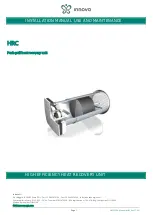
TROUBLESHOOTING and MAINTENANCE
© 2018 Global Welding LLC
Page
33
Operating Manual No: PWOM-215/250MP-001
6.3
TIG Welding Troubleshooting
NOTE
22
:
Weld quality is dependent on the correct consumables, proper welding
technique and
equipment maintenance.
Description
Possible Cause
Remedy
1.
Excessive bead buildup or poor penetra-
tion/fusion at weld edges.
Welding Amperage is too low
Increase weld amperage and/or change joint
preparation.
2.
Weld bead too wide or undercut at weld
edges or arc burning thru workpiece.
Welding Amperage is too high.
Decrease Welding Amperage.
3.
Weld bead too small or insufficient pene-
tration or ripples in bead are widely spaced
apart.
Travel speed too fast.
Reduce travel speed.
4.
Weld bead too wide or excessive bead
build up or excessive penetration in butt
joint.
Travel speed is too slow. Increase
travel
speed.
5.
Uneven leg length in fillet joint.
Wrong placement of filler rod.
Re-position filler rod.
6.
Electrode melts when arc is struck.
Electrode is connected to the “+” Positive
Output Terminal.
Connect the electrode to the Negative Output
Terminal.
7.
Dirty weld pool.
A
Electrode contaminated through contact
with work piece or filler rod material.
B
Gas contaminated with air.
A
Clean the electrode by grinding contami-
nates off.
B
Check gas lines for cuts and loose fitting
or change gas cylinder.
8.
Poor weld finish.
Inadequate shielding gas.
Increase gas flow or check gas line for prob-
lems
9.
Arc flutters during TIG welding.
Tungsten electrode is too large for the Welding
Amperage.
Select the right size electrode.
0.040 in. (1.0 mm) = 5 to 30 Amps
1/16 in. (1.6 mm) = 10 to 70 Amps
3/32 in. (2.4 mm) = 15 to 150 Amps
1/8 in. (3.2 mm) = 20 to 230 Amps
10.
Welding arc cannot be established.
A
Work clamp is not connected to work piece
or ground/torch leads are not connected to
the correct welding terminals.
B
Torch lead is disconnected.
C
Gas flow incorrectly set, cylinder empty or
the torch valve is off.
A
Connect the work clamp to the work
piece or connect the work/torch leads to
the correct welding terminals.
B
Connect it to the “-“ Negative Output
Terminal.
C
Set gas flow rate to 5 – 12 CFH, change
cylinder or turn torch valve on.
0.040 in. Tungsten @ 5 – 30 Amps = 5 – 10 CFH
1/16 in. Tungsten @ 10 – 70 Amps = 7 – 12 CFH
3/32 in. Tungsten @ 15 – 150 Amps = 10 – 15 CFH
1/8 in. Tungsten @ 20 – 230 Amps = 10 – 18 CFH
11.
Electrode melts or oxidizes when an arc is
struck.
A
No gas is flowing to weld zone.
B
Torch is clogged with dust.
C
Gas hose is cut.
D
Gas hose contains impurities.
E
Gas regulator turned off.
F
Torch valve is turned off (160S only).
G
The electrode is too small for the Welding
Amperage.
A
Check the gas lines for kinks or breaks or
cylinder contains gas.
B
Clean torch.
C
Replace gas hose.
D
Raise gas pressure to blow out impuri-
ties.
E
Turn on.
F
Turn on.
G
Increase electrode diameter or reduce the
Welding Amperage.
12.
Arc start is not smooth.
A
Tungsten electrode is too large for the
Welding Amperage.
B
The wrong tungsten type is being used for
the welding job.
C
Gas flow rate is too high.
D
Incorrect shield gas is being used.
E
Poor work clamp connection to work piece.
A
Use smaller diameter tungsten.
B
Use tungsten suitable for DC.
C
Use a flow rate of 5 – 18 CFH for the TIG
welding job.
D
Use 100% argon for TIG welding.
E
Improve connection to work piece.








































